Gone with the Wind Blu-ray Movie
HomeGone with the Wind Blu-ray Movie 
70th Anniversary Ultimate Collector's Edition / Blu-ray + CDWarner Bros. | 1939 | 233 min | Rated G | Nov 17, 2009
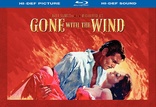
Movie rating
8.4 | / 10 |
Blu-ray rating
| Users | 4.9 | |
| Reviewer | 5.0 | |
| Overall | 4.9 |
Overview
Gone with the Wind (1939)
Story of the romance between the tempestuous Scarlett O’Hara and the dashing Rhett Butler, against the tragic backdrop of the Civil War.
Starring: Clark Gable, Vivien Leigh, Leslie Howard, Olivia de Havilland, Thomas Mitchell (I)Director: Victor Fleming, George Cukor, Sam Wood (I)
| Drama | Uncertain |
| Romance | Uncertain |
| Epic | Uncertain |
| Period | Uncertain |
| History | Uncertain |
| War | Uncertain |
| Melodrama | Uncertain |
Specifications
Video
Video codec: VC-1
Video resolution: 1080p
Aspect ratio: 1.37:1
Original aspect ratio: 1.37:1
Audio
English: Dolby TrueHD 5.1 (48kHz, 16-bit)
English: Dolby Digital Mono (192 kbps)
French: Dolby Digital 5.1 (384 kbps)
German: Dolby Digital 5.1 (384 kbps)
Italian: Dolby Digital 5.1 (384 kbps)
Spanish: Dolby Digital 5.1
Spanish: Dolby Digital Mono
Portuguese: Dolby Digital Mono
Japanese: Dolby Digital Mono
Subtitles
English SDH, French, German SDH, Italian, Italian SDH, Japanese, Portuguese, Spanish, Danish, Dutch, Finnish, Norwegian, Swedish
Discs
50GB Blu-ray Disc
Four-disc set (2 BDs, 1 DVD, 1 CD)
Playback
Region free
Review
Rating summary
| Movie | 5.0 | |
| Video | 4.5 | |
| Audio | 4.5 | |
| Extras | 4.5 | |
| Overall | 5.0 |
Gone with the Wind Blu-ray Movie Review
Warner takes yet another one of the glories of its catalog and delivers a brilliant Blu-ray which belongs on every collector's shelf.
Reviewed by Jeffrey Kauffman November 20, 2009If you ask most film fans to name just one movie which best sums up the Golden Age of Hollywood, or even film in general, chances are the majority of them are going to answer Gone With the Wind. This epic 1939 release, which still sits atop most all time box office champ lists (at least those with receipts adjusted for inflation), really shouldn’t have been such a bellwether production, though. With a famously troubled pre-production which forced producer David O. Selznick into groveling before his father-in-law, Louis B. Mayer, and then an equally troubled filming which famously didn’t even have a leading lady signed until second unit filming had already begun, and which then went on to weather, under duress, a change of director, Gone With the Wind really should have been the Heaven’s Gate of its day—a big, lumbering mess with attractive stars but without a point of view or dramatic momentum. And yet, despite all the odds against it, Gone With the Wind remains the absolute apex of what the old Hollywood studio system could achieve under the most trying of circumstances. Back in the day where every studio had its own amazing roster of virtuoso talents in everything from designers to composers to something as innocuous as craft services, this film shows what a group of dedicated professionals, each at the peak of their talents, could do. And this despite the fact that the Selznick studio didn’t really have the resources of any of the majors, hence its distribution deal with dad-in-law’s Metro-Goldwyn-Mayer. Now seventy years after Gone With the Wind’s Atlanta premiere, the film remains the gold standard for all which has come after it, and it has been one of the most widely anticipated releases on Blu-ray since the format hit consumer shelves. As has been their wont, Warner has devoted a lot of care to this lavish new collector’s edition, and I can’t imagine any serious Blu-ray devotee is going to want to be without it.
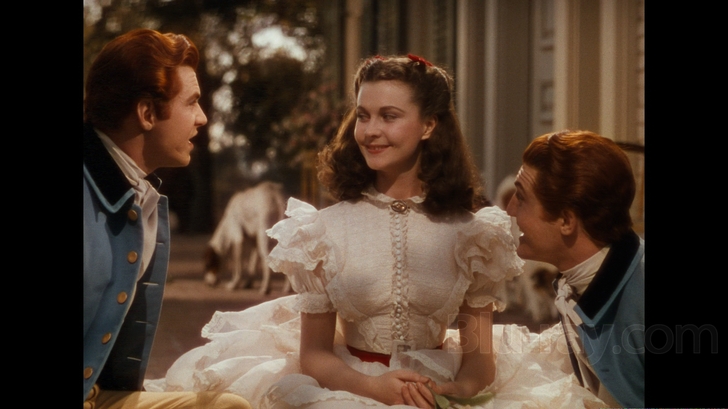
Scarlett O'Hara (Vivien Leigh) enchants the Tarleton Twins. That's future television Superman George Reeves on the right.
My introduction to this epochal motion picture was in one of the early 1970’s 70mm stereophonic re-releases. My mother was a huge GWTW fan, and by that I mean both the original novel, which she typically reread once every couple of years or so (one of her proudest book possessions was a pristine first edition of the tome, something I've heard is pretty rare nowadays), as well as the film. When this particular re-release was announced, she simply informed me I was going to go with her and my father. Need I tell you that Gone With the Wind was not exactly at the top of a very young boy’s “must see” list? And yet, I was transfixed by this film from the first frame (I was too young to know or care about the butchering the image received by being blown up and rematted to approximate the 70mm format). I still remember sitting with my jaw agape during the famous crane shot of Scarlett O’Hara (Vivien Leigh) walking amidst the wounded and dead Confederate soldiers. Even at that young, extremely innocent age, I knew that that shot at least was something spectacular. I also fell in love with Max Steiner’s incredible score, and in fact I was soon pounding away on the solo piano version of "My Own True Love." I was also schooled by my mom in the many differences between the original novel and the film, as she went into minute, almost page by page, detail of how the film altered and reordered the events in Margaret Mitchell’s best seller.
In fact adapting the novel was one of the biggest nightmares of David O. Selznick’s famously obsessive compulsive career. If you’ve ever read Rudy Behlmer’s absolutely fascinating book Memo from David O. Selznick (and you should if you haven’t), you’re well aware of the micromanaging to which Selznick subjected his underlings (Behlmer in fact contributes the exhaustive commentary to the film, doing his typically excellent job). Selznick was nowhere more putatively in control than during Gone With the Wind, a film he was proud to have optioned from under the noses of all the majors (including of course his father-in-law), and he knew, perhaps instinctively, that this was the film on which his entire reputation would rise or fall. Large swaths of the novel fell by the wayside under the repeated attempts of a truckload of scenarists (including Selznick himself), resulting in what could have been a hodgepodge of styles and approaches. Amazingly, though, the basic premise of the novel, a portrait of that most petulant of Southern Belles, Miss Scarlett O’Hara of the plantation Tara, and her ill advised love affair with dashing ne’er-do-well Rhett Butler (Clark Gable, in a role he was seemingly predestined to play), remained front and center in the final screenplay (credited to Sidney Howard, though a who’s who of other screenwriting legends contributed), even while a slew of the novel’s supporting characters (including two additional children for Miss Scarlett) never made it to the screen. Howard wisely streamlines the novel’s labyrinthine subplots and melts them down into what basically amounts to a quartet of starcrossed relationships. Scarlett pines for Ashley Wilkes (Leslie Howard), who marries his beatific cousin, Melanie (Olivia de Havilland). Perhaps in spite, mixed with just the right amount of naked lust, Scarlett, after a brief but tragic dalliance with Melanie’s brother, enters into a tempestuous affair, and ultimately an equally tempestuous marriage, with Rhett. Have I forgotten to mention this all plays out against the South’s entrance into the Civil War, with the devastating personal and societal repercussions that brought, at least for the white folks. Some historical apologists have in fact accused Gone With the Wind, in both novel and film form, for adhering to, if not outright promoting, racial stereotypes, but I would argue that the film is actually somewhat forward looking in presenting Scarlett’s slave maid, Mammy (the resplendent Hattie McDaniel), as a woman with a mind (and voice) or her own, not afraid to put her charge in her place if circumstances warrant. And really how can a film dealing with the end of the horrific slave era not indulge in some racial profiling, as it were, at least to some degree? While the film certainly doesn't really ever take a more politically correct stance abhorring slavery, I think it's unfair to say it glorifies the practice, other than giving it the glossy studio system patina that virtually every major film from that era displays.
This is a film in which virtually everything works, from the magnificent performances to the seamless direction of George Cukor and his replacement Victor Fleming (as well as contributor Sam Wood), to the amazing production design, the impeccable Technicolor cinematography and the unmatched magnificence of Max Steiner’s score. It was a foregone conclusion that Clark Gable would play Rhett, and he famously actually didn’t want the role as he feared he would never be able to rise to his public’s preconceived notions of what it should be. He needn’t have been concerned. Playing Rhett with just the right amount of rogueish wit, mixed with a surprisingly menacing undercurrent of bitterness and even menace, this is a textbook example of an actor overcoming his “star” image to actually inhabit the role. Vivien Leigh, of course, was largely unknown stateside at the time of her casting, and therefore had only the novel readers’ own mental images of Scarlett to compete with, instead of her own starry façade. She is simply perfection in this role, a scheming coquette with a steel will and flashes of temper that can take a first time viewer’s breath away. The supporting cast is similarly wonderful, with Howard’s Ashley Wilkes a study in noble self denial and tormented passions, and McDaniel’s superb Mammy both the comedy relief and, perhaps surprisingly, often the emotional anchor of much of the film. But the two standout acting honors must ultimately go to de Havilland, able to invest a pretty treacly character like Melanie with some grit and nuance, and the incredible Thomas Mitchell as Gerald O’Hara, Scarlett’s father, a proud southern plantation owner who pays the ultimate mental price for the south’s downfall. But really, one could pretty much single out any supporting actor in this piece and heap praises upon them; this is a film where even bit parts were cast with care and craftiness, offering a superb palette that only proves how deep the “back bench” of Hollywood was in those days. You’ll see a truly unmatched panoply of actors in various roles here, from Jane Darwell to future Superman George Reeves to Eddie “Rochester” Anderson to Butterfly McQueen, and they are all brilliant, sometimes in roles that only grant them mere seconds of screentime.
But the performances are only one part of Gone With the Wind’s enduring magic. This is a film which virtually defines the epic, at least as it was at the acme of Hollywood’s Golden Era that most heralded year of 1939. Ernest Haller and Lee Garmes brought new splendor to the then still relatively untested medium of three strip Technicolor, offering an eye-popping array of colors that are only more impressive in this new Blu-ray presentation. The legendary William Cameron Menzies was on hand as overall production designer, and along with William Plunkett’s impeccable costume designs, the viewer is whisked by their mastery into the Antebellum South as in perhaps no other film. When one considers that this film begins at the height of the south’s prestige and extravagance, and then devolves into the horrors and degradations the Civil War brought home to bear, it’s an all the more remarkable achievement. Anyone who has seen this film’s depiction of Tara pre- and post- battle will know exactly to what I refer.
Against all odds the screenplay also offers a compelling through line, though truth be told many find the second half of the film less riveting than the first. There are so many classic moments in this film one almost seems boorish to pull out a few for the purposes of a review. Rhett and Scarlett’s first meeting, with their hilarious epithets tossed at each other, setting up their relationship in two brief lines of dialogue, is a perfect example of precise and concise screenwriting. The absolutely legendary burning of Atlanta segment remains one of the most jaw dropping spectacles ever committed to film. Scarlett’s anguished cry to the heavens that she’ll never be hungry again as the film builds towards its incredible intermission is indelibly imprinted on virtually every Gone With the Wind viewers’ mind. Of course the famous crane shot to which I referred earlier still remains one of the most impressive technical achievements of all cinema, especially with the technology available to the filmmakers of that day. Emotionally devastating moments like Scarlett’s shooting of the Union soldier in the denuded Tara are as gut wrenching on the fiftieth viewing as they are on the first. All of these moments and more simply go to prove why Gone With the Wind is the enduring masterpiece it is; it’s a film whose freshness never seems to wilt despite how iconic its images have become. You can laugh yourself silly at the famous Carol Burnett parody Went With the Wind, especially with its classic “drape dress” gag, but then you can return to the original and be just as emotionally involved as you ever were by Scarlett’s shenanigans to impress Rhett. It’s a rare film that can retain this visceral level after so long, and after having been seen so often and just as often satirized and parodied through the years.
Finally, one must properly acknowledge the unobtrusive yet brilliant direction, largely by Fleming, but with several key scenes helmed by either Cukor or Wood. Obviously the tonally perfect performances are a credit to these directors' mastery, but the epic sweep of this film must really be attributed squarely to their quiet professionalism. In an era when directors love to call attention to their own manic camera work, it's notable to see how thrilling Gone With the Wind is with largely static, or at least non-showy, shots. Fleming simply plants his camera down and lets the actors and the images tell the story. That means when there is some camera movement, as in the famous crane shot, it becomes all the more thrilling and riveting. A lot of younger directors could, in my not so humble opinion, learn a lot from this modus operandi, a component of the director's craft that has, sadly, disappeared a la this particular film's title.
The Antebellum South may indeed have perished with the winds of time, but there’s little doubt Gone With the Wind will forever retain its status as one of the greatest films, if not the greatest film, ever made.
Gone with the Wind Blu-ray Movie, Video Quality 
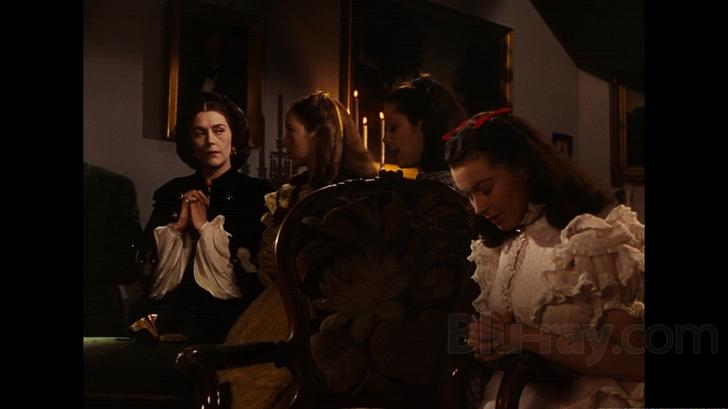
Warner has taken its catalog titles more seriously than perhaps any other major studio currently releasing its classics on Blu-ray. If they haven't always hit things completely out of the ballpark (How the West Was Won, a triple play but just shy of a home run), they're out there swinging for the fences and more often than not connecting big time and providing film lovers repeated reason to celebrate. The recent Blu-ray upgrade of The Wizard of Oz in its Collector's Edition is just the latest example of Warner going the extra mile in their restoration efforts, and Gone With the Wind stands proudly next to Oz as one of the sharpest looking high definition images of a classic film title yet delivered to the public. Encoded via VC-1, Gone With the Wind's original 1.37:1 image is a marvel to behold, with a beautifully rich and complex lifelike film texture that has noticeable but never overwhelming grain. Colors are astoundingly brilliant throughout this film, with gorgeous saturation and at times breathtaking hues. Scarlett's scandalous red dress has never been more crimson, and Leigh's eyes sparkle and shine with depth and luster as never before. I will say that some videophiles may find the Technicolor registration just a tad on the yellow side, which is noticeable mostly in the skin tones. But just take a gander at the deeply saturated Technicolor reds in some of the screenshots I've provided and you have a good indication of how spot on the bulk of this film's color is. As mentioned below, this film underwent one major scrubbing a few years ago for its 4 disc DVD release, and the new 8K re-do for this release is simply amazing. Depth of field reveals a level of detail in backgrounds and matte paintings as never before, and items at the forefront of the image simply are astoundingly well detailed. Warner has done itself proud with this release and I doubt there will be any major complaints from even the most demanding viewers.
Gone with the Wind Blu-ray Movie, Audio Quality 
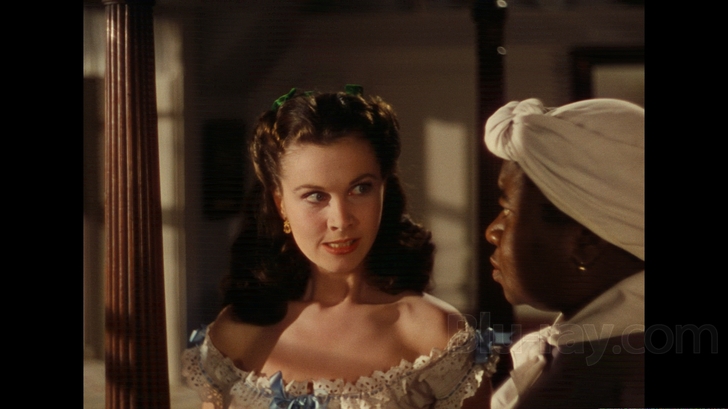
Gone With the Wind offers both the original mono track as well as a repurposed Dolby TrueHD 5.1 mix, which is rather conservative in its surround ambitions, but which cleans and clarifies the source material rather dramatically at times. A lot of purists decry these surround reimaginings, but I have a hunch few will argue about the propriety of this particular renovation. Dialogue is almost inescapably in the front center channel. Surround channels kick in where you'd expect them to, in such bombastic segment as the Civil War battles. Steiner's score typically also fills all the channels. I was rather impressed with the opening up of the sound itself. Too often Dolby tracks, even lossless high def iterations, sound to me like they're overly compressed, especially on the high end. You'll notice quite a bit more hiss on the mono track, but that noise reduction in the TrueHD track does not mean a loss of the high end, which is to be lauded. This is a subtly repurposed 5.1 mix that preserves the front and center soundfield of the original soundtrack while gently nudging it into the surround channels at appropriate times. While even the TrueHD re-do can't completely overcome the technical limitations of the original recordings (you'll hear this in the somewhat boxy sound of the music mostly), this is really quite an excellent upgrade that should delight even the most discriminating listener.
Gone with the Wind Blu-ray Movie, Special Features and Extras 
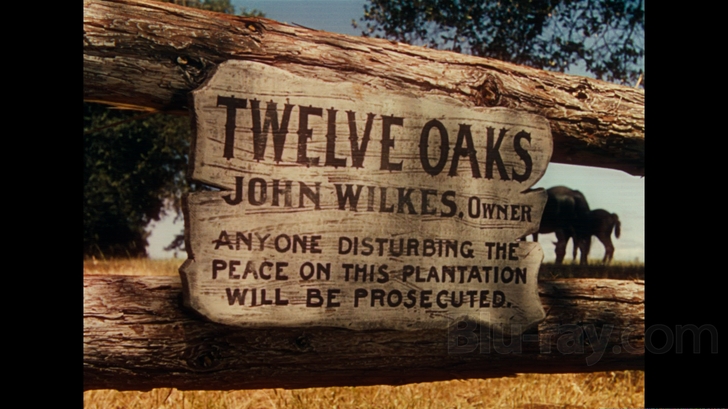
The Antebellum South may indeed have perished with the winds of time, but there's little
doubt Gone With the Wind will forever retain its status as one of the greatest films,
if not the greatest film, ever made.
The Box
Blu-ray collectors may have seen their wallets slimmed down considerably with the slew of
collector's editions recently, but few are going to complain about spending money on this
lavish new box for what is arguably the greatest film from Hollywood's Golden Era. Similar in
size and shape to the Snow White Diamond Edition I recently reviewed, as well as
Warner's recent Wizard of Oz Collector's Set, this Gone With the Wind offers
several supplements ported over from the last DVD release, as well as several new ones.
The box itself is clad in a rich red velvet and features the iconic painting of Gable holding
Leigh as the flames of Atlanta burning rage in the background. The main extra-disc feature
is a beautiful 52 page hardcover book which has a wealth of pictures and details about the
film. While not, perhaps, quite as opulent as the oversized book that came with the
Snow White set, it certainly is in a league with its Wizard of Oz counterpart.
For those unfamiliar with Behlmer's The Memos of David O. Selznick, several are
reproduced here, all germane to the casting and crew hiring, as well as the budgeting, of
Gone With the Wind. They show a producer absolutely fixated on the minutiae of an
epic scale production and offer a keen insight into a man seemingly compelled to handle
every last detail himself. Also included is a reproduction of the Atlanta premiere's souvenir
program, a fascinating little piece of memorabilia that shows how studios promoted their
films back in the days when audiences were a bit more starry-eyed than they are now.
Finally, ten paintings of the plantations of the film are included, all on heavy
cardstock.
The Discs
The two Blu-rays and one SD-DVD are contained in a trifold case. A standalone soundtrack
CD is packaged separately.
Disc One:
The main feature, running at around four hours, is on a BD-50 disc and contains "only" the
Behlmer commentary as its one bonus. I say "only" because this is one of the most
authoritative, yet easily accessible and unfailingly affable, commentaries ever recorded.
Behlmer, unlike his frequent counterpart Drew Casper, doesn't deal in faux
profundities or outright inanities, and instead imparts one fascinating fact after another
about the film and the filming. I'm not sure if he was also schooled by my late mother, but
he also goes into detail about the differences between the Margaret Mitchell source novel
and the final film version. Though you'll end up spending eight or so hours watching the film
and then rewatching with Behlmer's commentary, I can't recommend it highly enough.
Disc Two:
The bulk of the film's supplements are offered on this second Blu-ray disc. Unfortunately
they're all in standard definition and several have been released previously.
- The Making of a Legend: Gone With the Wind (SD, 123 minutes): This documentary has cropped up regularly on TCM and was included on the previous DVD release of the film. Filled with fantastic information about the history of the property, and its tortuous production, Legend also offers a great assortment of screentests and other archival film.
- Gone With the Wind: The Legend Lives On (SD, 33 minutes), is a sort of sequel to the above supplemental feature, focusing on the now 70 year old legacy of the film. Emphasis on film preservation and some of the collectors of Wind memorabilia (who will no doubt be including this set in their treasure trove) is included.
- 1939: Hollywood's Greatest Year (SD, 68 minutes), is one of the better extras on the set, devoting an in-depth look to that most storied year of Hollywood's halcyon days. M-G-M may have had the "big two" that most people associate with that year, Wind and Wizard, but as this feature makes abundantly clear, the studio system was in full swing with high style at all the majors, and there was a bumper crop of classics that year.
- Gable: The King Remembered, (SD, 65 minutes), gives us a nice Biography-esque overview, hosted by Peter Lawford. of the man and the movie star.
- Vivien Leigh: Scarlett and Beyond, (SD, 46 minutes), is a little bit more surface level than the Gable effort, but with hostess Jessica Lange pointing the way, does venture into Leigh's mental issues which affected her later career. Lange, of course, played another famously troubled actress, Frances Farmer, an actress who was in fact considered for the role of Scarlett, as you will see if you look quickly in a "potential casting sheet" in The Making of a Legend.
- Melanie Remembers: Reflections by Olivia de Havilland, (SD, 39 minutes). At last we get some first-person reminiscences, and with the ever lovely and gracious de Havilland providing them, you know you're in for a rare treat. What may surprise you is how impish the star was and still is when this was filmed.
- The Supporting Players, (SD, 30 minutes). I mentioned just a few of the incredible supporting cast of this film in the main review, which should give you some indication of the variety and quality of actors covered in this excellent featurette.
- Restoring a Legend, (SD, 18 minutes). Though this focuses on the 2004 UltraResolution restoration for the film's 4 disc DVD release, this is still a fascinating look at the incredible effort taken to preserve and restore classic films like these. All film lovers will both be impressed by and grateful for the efforts depicted in this brief featurette.
- Two newsreels are offered, Dixie Hails Gone With the Wind (SD, 4 minutes) and Atlanta Civil War Centennial (SD, 4 minutes), both of which offer glimpses of premiere festivities for the film itself.
- The Old South, (SD, 11 minutes), a sort of documentary exposition of the cultural background of plantation life, this is probably too apologetic for the South's justification for slavery ("someone has to pick the cotton," to quote an incredibly racist song of days of yore), but is interesting at least from an historical perspective.
- International Prologue, (SD, 1 minute), another expository piece which acted as prelude to the foreign release of the film, offering some background on the Civil War.
- Foreign Language Versions, (SD, 3 minutes), gives us a compendium of snippets of foreign language versions of the film. "Demain est une autre jour."
- Movieola, (SD, 97 minutes), is a pretty lame made for television movie with Tony Curtis as David O. Selznick. Curtis simply doesn't have the look or feel for this legendary character, and the rest of this enterprise is similarly uninspiring.
- Finally five trailers from the original release and various re-releases are
offered.
Finally, on a standalone SD-DVD flipper, the enormous in scope When the Lion Roars three part documentary is featured. An exhaustive look at the history of M-G-M, hosted by Patrick Stewart, this all-inclusive overview is such an onslaught of archival film it's like a virtual who's who of Hollywood. Part One, "The Lion's Roar," delves not only into the studio's nascent years but more importantly the epochal relationship between its two titans, Louis B. Mayer and Irving Thalberg. Most Golden Age fans will most likely be more entranced by Part Two, "The Lion Reigns Supreme," which covers the era of the 1930's and 1940's, when M-G-M was the Tiffany of movie studios. The third part, "The Lion in Winter," chronicles the slow, sad decline of the studio and its many subsequent owners.
Disc Four:
As mentioned above, a standalone CD of Max Steiner's amazing score is also included. Pay attention to how effortlessly Steiner weaves folktunes in and out of his original underscoring.
Gone with the Wind Blu-ray Movie, Overall Score and Recommendation 
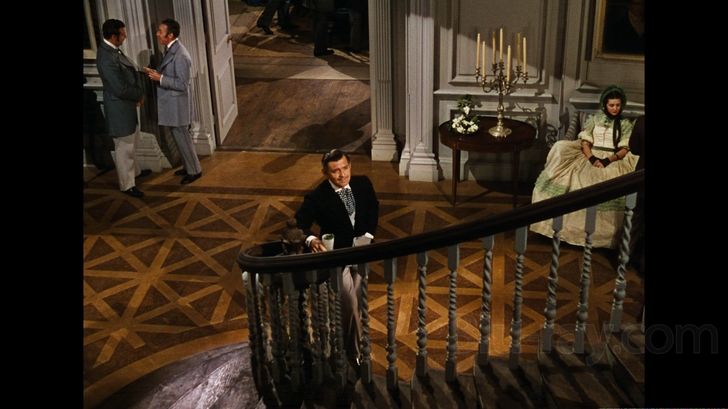
Frankly, dear, you will give a damn about this excellent Blu-ray release. A classic film has been done proud by Warner, and once again Gone With the Wind is set to captivate audiences worldwide in an impressively upgraded version.
Other editions
Gone with the Wind: Other Editions

Gone with the Wind
Iconic Moments
1939

Gone with the Wind
70th Anniversary Edition | Iconic Moments
1939

Gone with the Wind
70th Anniversary Edition | Academy Awards O-Sleeve
1939

Gone with the Wind
75th Anniversary Diamond Luxe
1939

Gone with the Wind
1939

Gone with the Wind
75th Anniversary Ultimate Collector's Edition
1939

Gone with the Wind
Scarlett Edition
1939

Gone with the Wind
70th Anniversary Edition
1939
Similar titles
Similar titles you might also like

Doctor Zhivago
45th Anniversary Edition
1965

Atonement
2007

Cold Mountain
2003

The English Patient
1996

Legends of the Fall 4K
30th Anniversary
1994

Casablanca 4K
80th Anniversary Edition
1942

Cleopatra
50th Anniversary Edition
1963

Out of Africa 4K
40th Anniversary
1985

Cleopatra
1934

Wild River
Fox Studio Classics
1960

The Scarlet Empress
1934

Quo Vadis
1951

The Last of the Mohicans
Director's Definitive Cut
1992

Rome: The Complete Series
2005-2006

The Leopard
Il gattopardo / Italian and American Versions
1963

The Pillars of the Earth
2010

Spartacus 4K
1960

War and Peace
1956

The Reader
2008

Mrs. Miniver
1942